Monday 18 August 2008
After a great breakfast with David and Nell (with lots of discussions about everything from country life to the international situation) we jumped into the Earthroamer at 8.00am and took some photographs outside the Birdsville Hotel.
Dick once owned the Birdsville Hotel – for a day – but that is a different story. David Brook and a partner currently own the Birdsville Hotel, and he will sell it to you for $6.5 million. That is quite a bargain when you consider that one day Birdsville could be a city like Denver – or so the locals say.
We checked with the GPS – direct as the crow flies it is 1,440 kilometres to Byron Bay. It will take us a much longer distance.
We crossed the Diamantina River and headed towards the Betoota on a good gravel road. There is no doubt that the Diamantina Shire (of which David Brook was President for many years) has the best gravel roads in the world. They are beautifully graded and well signposted. Let’s hope the National Trust classifies these roads and they can never be sealed!
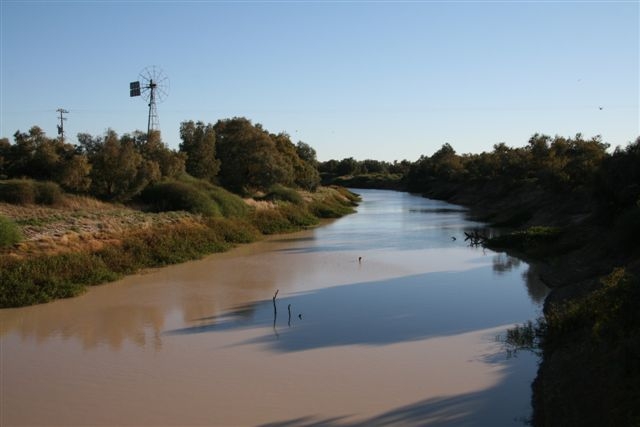
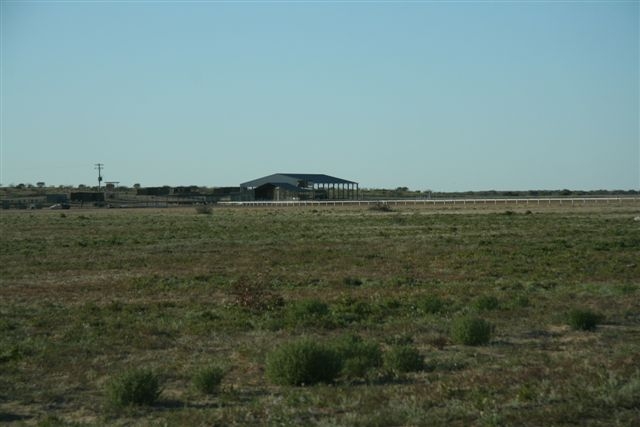
It was 49° Fahrenheit (9° Celsius) and very green. The local rain certainly makes a difference in this area – which some people would class as desert. The locals would certainly call it an arid zone. Beautiful wildflowers were beside the road so we would stop to take photographs.


The road was cutting through sand hills. This is the northern edge of the Sturt Stony Desert and we crossed the route of Burke and Wills – the famous explorers who successfully walked from Melbourne to the Gulf of Carpentaria, and died on their retreat.
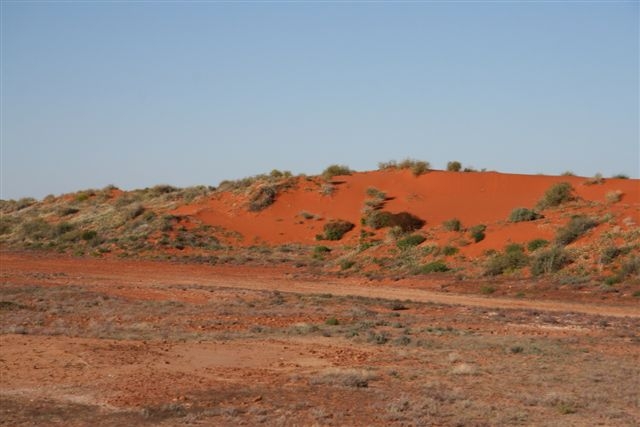
There were lots of cattle, an occasional emu, and even one lone feral pig marching along beside the road. If any of the locals had seen the pig we are sure it would have been shot instantly!
So far from Alice Springs, about every 50 kilometres or so we passed a very high “guyed tower.” These towers are part of Telstra’s ground based telephone system. It was decided over two decades ago that Australia should have a ground based telephone system and a country person should be able to get a telephone for the same cost as someone in the city. The cost must have been tens of millions of dollars, however it has the advantage that if ever the satellite system was taken out, Australia’s telephone system would still have communication via the ground based system. Eventually we would imagine that fibre optic cables will reach these towns to give broadband access to country people. That will probably mean that the microwave tower system is removed.
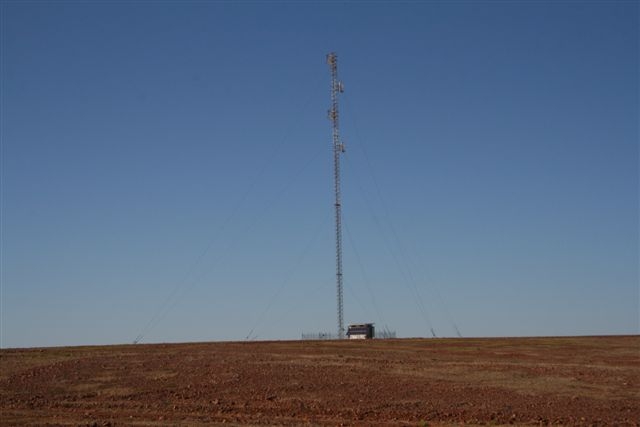

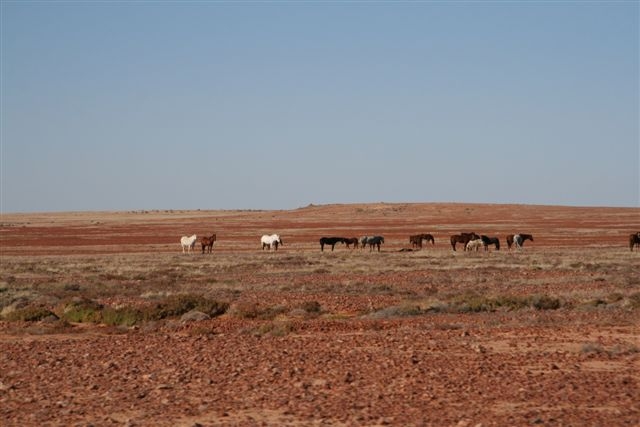
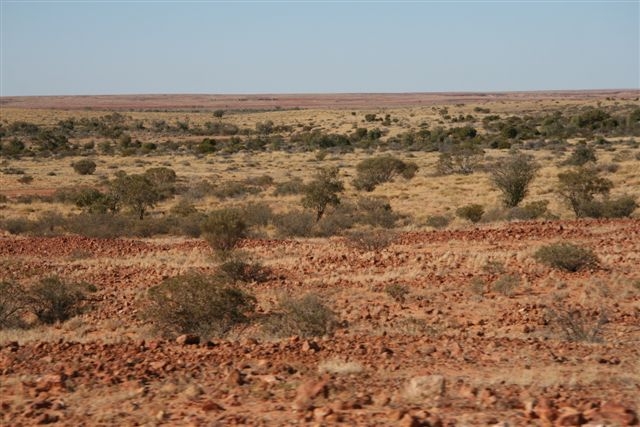
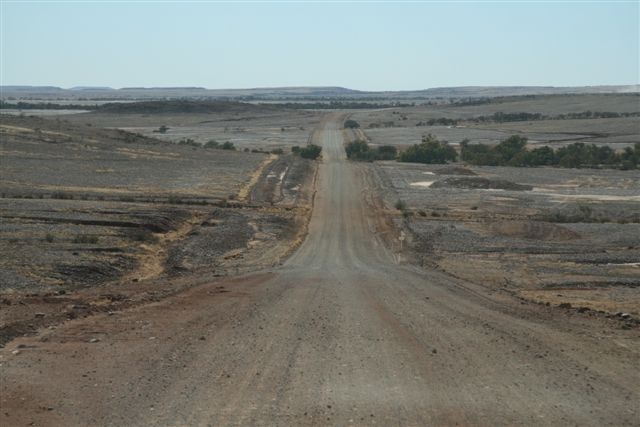
At 10.20am we arrived at the old Betoota Pub. It is no longer open. Our friend Simon Remienko, an immigrant from Poland, owned and operated the pub for many years. He was originally a grader driver before buying the hotel. Simon was quite an eccentric. We would call in with the Cessna Caravan to say hello. In those days you could taxi right up to the back door of the pub. We drove around to the rear of the pub to visit Simon’s grave. It stated that he was the publican from 1959 to 1997. Simon, rest in peace. In his will, Simon left the pub to David Brook. We are hoping that David will get it going again one day, but that will be quite a job and require quite a lot of money.

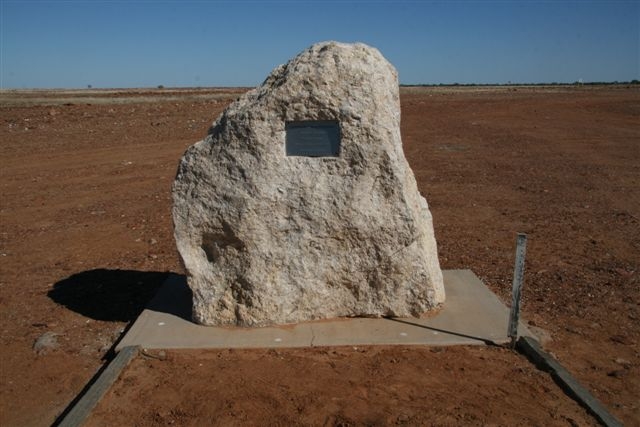
At 10.25am we stopped at Deon’s Lookout and made a cup of tea with Saos. Deon’s Lookout has a plaque which is a memorial to David and Nell Brook’s son, Deon, who died on Anzac Day (25 April) 1996 in a helicopter accident about 18 miles to the south west of this beautiful location. He was only 20 years of age.

It was 68° Fahrenheit (20° Celsius) and windy. We could see in the magnificent panorama vehicles driving along the road, creating dust like a mini dust storm.
We left at 11.05am and entered the Boulia Shire once again. At 12.15pm we stopped to look at a mountain with a tunnel. Lunch consisted of hot dogs cooked on the stove. Mount Henderson was on our right, with an unusual small hole that had eroded through. It was similar to the hole that Dick and Pip had seen in Norway during their helicopter flight around the world – although that one was a lot larger.
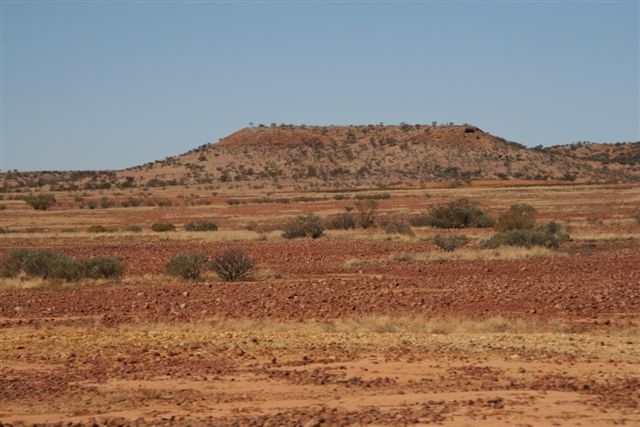
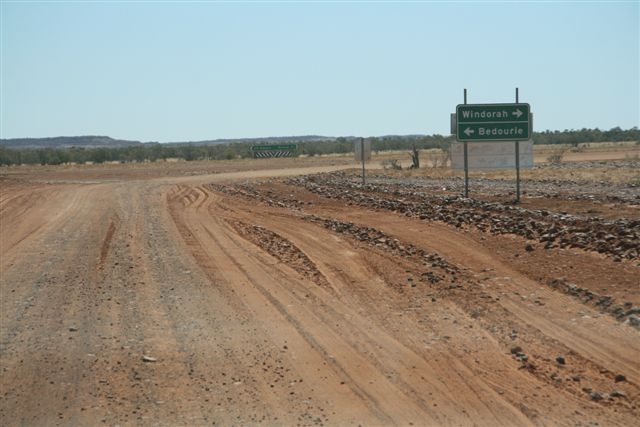
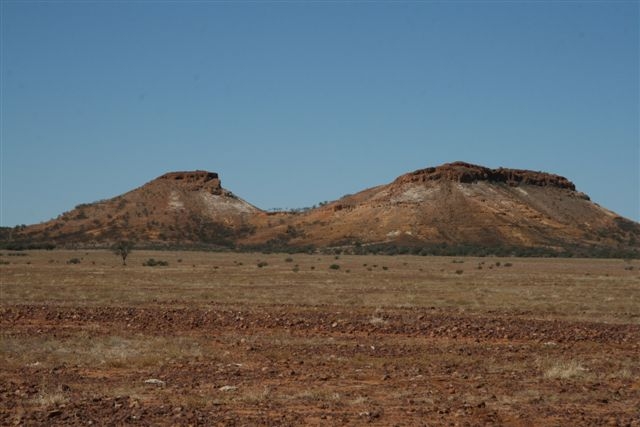
Every time we stopped we would inspect the vehicle closely, because with 7.5 tonnes, vibration can create havoc on any road. Dick noticed that the pressure valve on the compressor cylinder had broken clean off. The brass fitting had obviously fatigued. We were not planning on using the compressor – we have had no punctures during the whole trip – so Dick taped up the fitting to be fixed later.
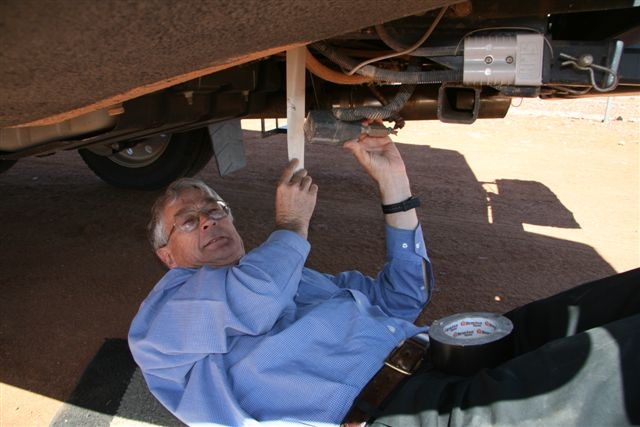
We were now in the Lake Eyre basin and heading towards Windorah, which is on the Cooper Creek. We arrived just after 2.00pm and thought we would call into the local café for a bite to eat. We had no luck. There is a sign which says, “Café closed for lunch from 2 to 3pm.” What about the people who want to go to the café for lunch? They obviously miss out. Then again, it is probably making so much money that the café doesn’t need to open.
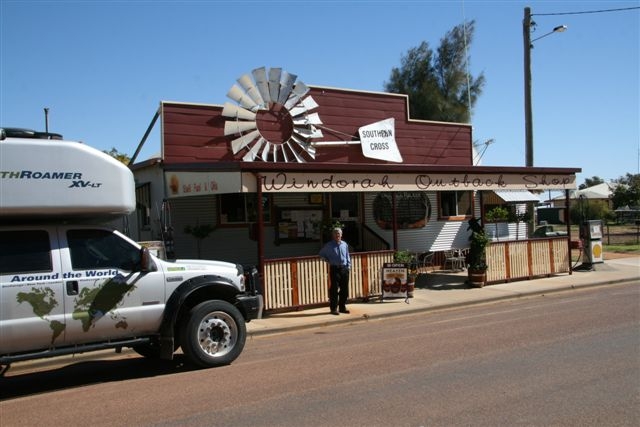
We remembered Windorah fondly from the first Bourke to Burketown Bash – a car trial to raise money for Variety – the Children’s Charity. A slightly inebriated John Newcombe (the famous tennis player) took on the locals, as well as the car drivers from the Bash. It was at night, and even then John Newcombe effectively thrashed everyone.
We stopped at an amazing solar project, with huge solar dishes – each generating 30 kilowatts by focusing the sun onto a very small, water cooled, photovoltaic array. Obviously it only operates when the sun is out – there is no storage of the power at all.
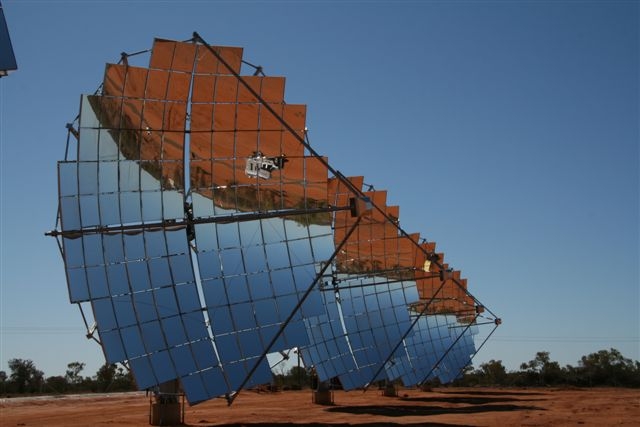
Dick had a quick check at the airport to see if jet fuel is available. Windorah is a great place to stop.
After leaving Windorah, we crossed the many channels of the Cooper Creek. It starts in the channel country, which is affected by the summer monsoons and occasionally floods to enormous widths. Once every 20 or 30 years, the water actually reaches Lake Eyre – our inland lake which is below sea level. Have a look at a map to see the distance between Windorah and Lake Eyre. It is mainly sand hills and the river somehow winds its way through. It might take 18 months from the time of the flood in Queensland before the water arrives at Lake Eyre.
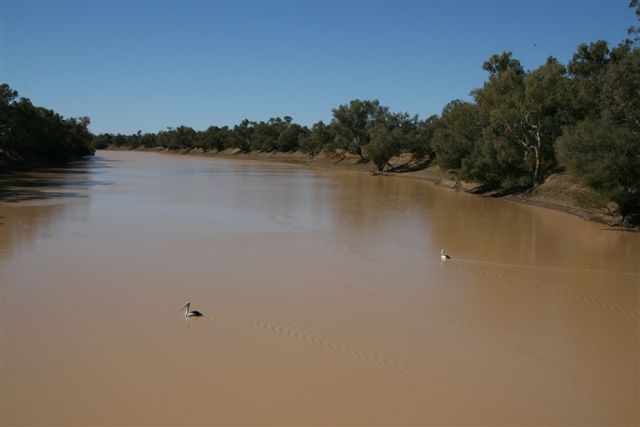
Part of the creek actually had water in it, with groups of people camping on the banks. As we drove further to the east, we came across large flocks of green budgies. The budgerigar is an Australian native bird, and its natural colour is green. The different colours of blues and yellows that you see in the pet shops have all been bred by enthusiasts – i.e. they are man made.
The road we were on was a single lane width bitumen road. The Earthroamer is quite wide, so it required concentration to keep on the bitumen. When ever a vehicle was coming in the other direction (which wasn’t often) we had to move off on to the gravel – risking a rock hitting the windscreen. Dick and Pip took turns driving. Pip drove extremely well considering the huge weight of the Earthroamer. It is a truly magnificent vehicle when on decent gravel and bitumen roads.
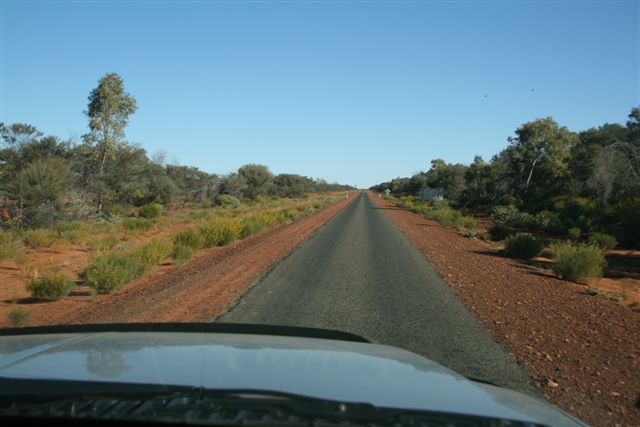
Now we were driving in grasslands, with not many trees. We noticed more “road kill” than we had seen anywhere in the world. By “road kill”, we mean poor dead kangaroos and wallabies that had been hit by cars at night. We had decided not to drive at night – not just because we would miss the scenery, but it is so easy to hit a kangaroo. We probably would have passed hundreds of dead kangaroos. Of course, there are advantages for some native animals as the wedge-tailed eagles and crows were feeding on the carcasses.
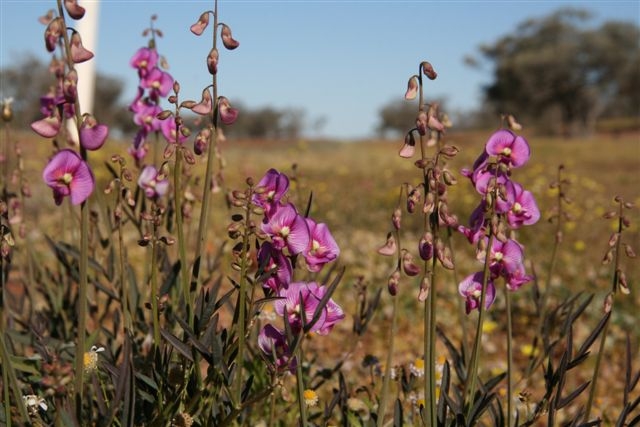
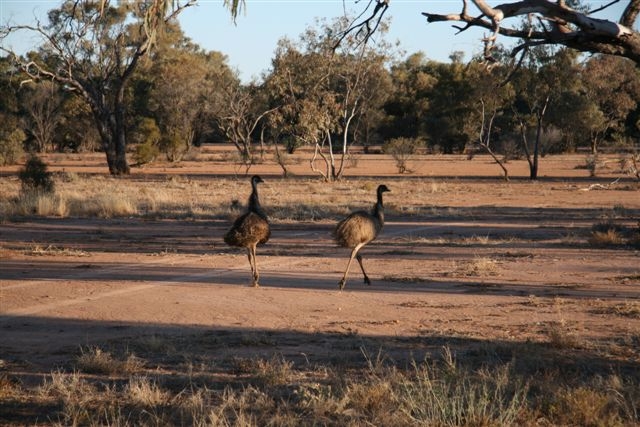
Thirty-seven kilometres before Quilpie we came across our first sheep. This used to be quite a sheep area, however the Australian native dog (the dingo) tends to kill the lambs.
We crossed the Grey Range and arrived at Quilpie at 5.45pm. All the shops were closed. We were directed to the Channel Country Caravan Park as we had decided we should at least experience an Aussie Caravan Park. Naturally we preferred camping out in the bush with our own beaut fire. We paid the $22 and were directed to a concrete pad. We even plugged our power in for the first time in Australia. It is interesting that these caravan parks are quite small and everyone is crammed together, but no one seems to notice. We considered the difference from the Scottish caravan park, where there were rules everywhere – and even huge steel claws which came up to stop anyone driving out at night. This was very Australian, with absolutely no rules at all, and everyone was very friendly.
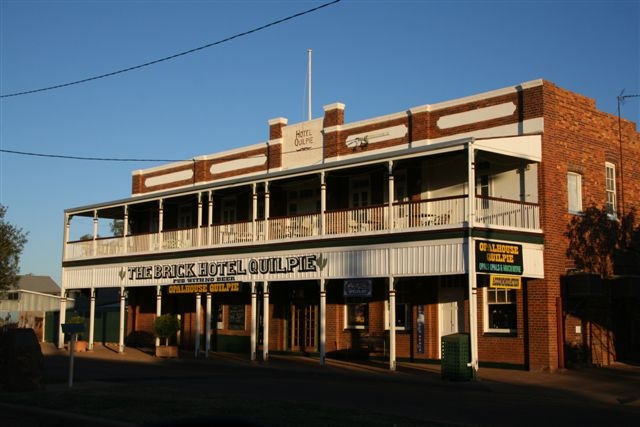
We watched 4 Corners on ABC TV. Isn’t it incredible? The little TV set Dick had bought in Edgeware Road in London has been working all around the world. Once you put the aerial up and put it on search, it can find stations virtually anywhere. It will be interesting to see if it works back in the USA.
Total today 568 kms 38,682 kms since Anchorage, Alaska.
Click here for the next day
Click here to return to the Smith’s Overland main index page.
